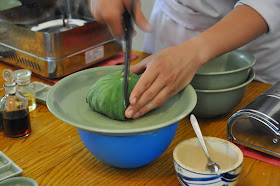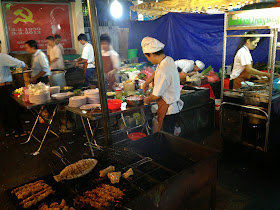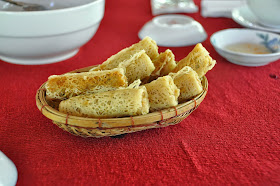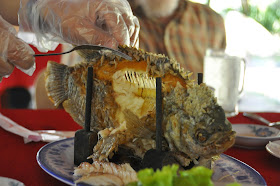Zucchini seeds are usually planted in the beginning to the middle
of July. By early August there would be
lots of blossoms, male flowers on long stalks and female flowers carrying baby
squashes at their ends. Upscale produce
shops usually carry only the female flowers because of the eye-appeal of their cute
little zucchinis. Farmer’s markets also sell
the much more inexpensive male flowers. Mr.
A bought a big bundle of them for just a dollar (about 100 Japanese yen).
 |
| $1 worth of
male zucchini flowers |
 |
| Male zucchini flowers with stems removed |
The usual way to cook zucchini blossoms is to fry them after
removing the stamens (male) or the pistils (female). Mr. A followed a Fiori di Zucca Fritti recipe from Cucina Giuseppina, a cooking school in Certaldo that “rarecat”
attended during her trip to Tuscany, Italy.
Here is the gist of the recipe:
1.
Crack 3 eggs into a bowl; add 2 heaping tablespoons of
flour per egg.
2.
Add 2 ice cubes into the mix. Stir to combine.
Add water if
necessary till the batter has the consistency of whipping cream.
3.
Heat an inch or less of oil in a frying pan (there is no need to use as much oil
as for deep frying). Test the temperature by dripping a little bit of batter into the
oil. It should cook reasonably fast but should
not turn brown
right away.
4.
Dip the flowers into the batter one at a time. Wipe flower along the side of bowl; turn flower 180 degrees and wipe
again to remove as much of the batter as possible. The flower should have a very thin coating of batter.
5.
Fry them in oil till done, cooking time should be 4 or 5 minutes per side.
6.
Salt flowers while they are still hot.
Mr. A followed the recipe
with two minor changes. Instead of
getting a smooth consistency, he stirred the ingredients just enough to
incorporate them into a lumpy batter. He
did it deliberately to mimic the way chefs at high-end tempura restaurants in
Japan made tempura batter. Mr. A also used
much less than an inch of oil so his fried blossoms turned out rather flat
instead of fluffy. Mr. A tasted the
batter and salt when he ate the fried plain flowers but not much else. He found out later that he was supposed to
eat the fritto right out of the pan while it was super hot. Mr. A also used some of the blossoms as a
topping for a bowl of Japanese somen noodle.
 |
| Frying male zucchini flowers |
 |
| Somen noodle with fried zucchini blossoms and pork |
A few days later, Mr. A fried some stuffed female zucchini
blossoms.
He blended fresh ricotta (about
one tablespoon per flower), some fresh Mozzarella and a small amount of
Parmigiano-Reggiano
in a food processor until they form a smooth paste.
He stuffed the flowers and fried them in a
cast iron frying pan with about half an inch of oil.
 |
| Fried female zucchini blossoms with cheese stuffing |
The fried blossoms looked much better this time. They also tasted better. The stuffing was soft and fluffy (ricotta)
with some creaminess (Mozzarella) and nutty (Parmigiano). The baby zucchinis were delicious.
The flowers themselves were still bland. Mr. A wondered whether stuffing them with a
paste of rock fish and white shrimp would help.
That would be a future project.



























